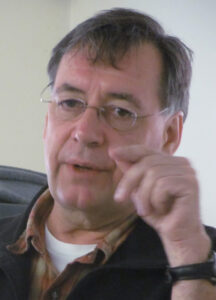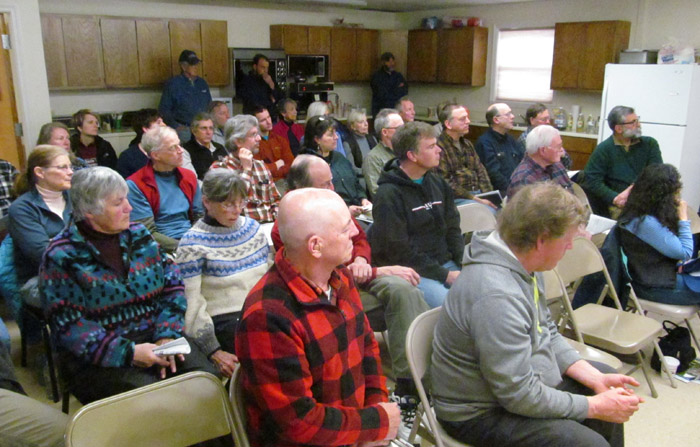By Mark Frost, Chronicle Editor

Mark Whitmore, a forest entomologist at Cornell, is widely regarded as the expert on Hemlock Woolly Adelgid and on how to combat it.
The insect, found this summer on the east shore of Lake George, poses a major threat to the Eastern Hemlock, the lake’s dominant tree species and a major presence in the Adirondacks and eastern U.S.
“I started the New York State Hemlock Initiative six years ago and I’ve been working on adelgids (pronounced, uh-DELL-jids) for 40 years, the hemlock woolly adelgid (HWA) for the last 20,” Mr. Whitmore told The Chronicle in a phone interview from Ithaca on Monday.
He said, “The state a few years ago stepped up when they realized the threat to the hemlock resource and they funded my lab significantly and really made a big difference in our ability to function.”
Mr. Whitmore, his team, and the Department of Environmental Conservation swung into action this summer at Lake George, along with the Adirondack Park Invasive Plant Program and the Lake George Land Conservancy, after a camper spotted tell-tale white woolly egg masses on the hemlock tree needles at a site in the Narrows on Black Mountain Shore.
“I’ve had three of my people working up here,” he said. “We’ve spent countless hours out there surveying all throughout August and September, at least three days a week. We’ve covered a lot of territory.”
“DEC has really been the primary mover in this case,” said Mr. Whitmore. “They’ve been doing a fabulous job providing us (what’s been needed), getting us out there in boats, and they’ve supplied numerous people to help in the survey.”

The infestation of Hemlock Woolly Adelgid was found to extend across 250 acres. But Mr. Whitmore explains, “The thing you have to understand is the infestation is really focused in smaller areas” within the 250 acres.
Its presence is closer to the shoreline, which Mr. Whitmore believes indicates HWA was spread by birds.
Asked how researchers can identify evidence of the tiny bug in trees that can exceed 100 feet in height, Mr. Whitmore said, “Ninety-nine percent of the time all the surveying is from the ground.”
He said that in the life cycle of the adelgid — which asexually reproduces in two generations a year — “when the eggs hatch is the only mobile stage….A ‘crawler’ can’t go very far. It just winds up in a spot and settles.”
“Invariably, detection is good on the lower branches,” said Mr. Whitmore. “I think the upper canopy remains untouched largely until the tree is unhealthy.”
In the next two weeks, the infested Lake George hemlocks are to be treated with chemical insecticides, fast-acting Dinotefuran and longer-acting Imidacloprid.
When The Chronicle expressed surprise at the apparent consensus supporting use of insecticides in the Adirondack Park and specifically alongside Lake George, Mr. Whitmore noted, “In the 80s as a graduate student, I was totally against chemical use. I don’t take it lightly. To save these trees, some of which are hundreds of years old, that’s the only option we have available.”
He added, “Times have changed. These chemicals are environmentally very responsible.”
But biological controls is the method Mr. Whitmore is pursuing in the longer run.
“I grew up in Washington State where the Hemlock Woolly Adelgid is native,” he said, but that it doesn’t imperil the Western Hemlock because HWA has so many insect predators of its own there.
A beetle and two types of silver fly are two of “the biological controls I’ve been working on for the past 12 years.” See separate article.
Asked about officials’ statement that 80 percent of the trees around Lake George are hemlocks, Mr. Whitmore wouldn’t put a percentage on it, but he said, “I didn’t realize how much hemlock there was until I started doing the surveys.”
As to trees species around the lake , he said, “Hands-down hemlock is the winner, except on the east side of the Tongue peninsula,” where he said the steep, dry terrain isn’t conducive to hemlock.
Mr. Whitmore also marvelled at the size of some of the hemlocks they encountered.
Its dominance is only part of why hemlocks are getting priority treatment. (Finch Paper’s forester told The Chronicle that hemlock is 45% of the fiber used in making its paper.)
And Mr. Whitmore said treating hemlocks with insecticide is “a lot less expensive and it lasts a lot longer — as long as seven years” vs. treating other trees.
Mr. Whitmore said treating ash trees for Emerald Ash Borer costs much more — “$5 per diameter inch” — and must be done every three years.
He said the situation for ash is bleak enough that he’ll look to save just a few of the several that line the long driveway into his home. “I’ll treat my favorite male and my favorite female,” he said, feeling it’s futile to try to treat them all.
Hemlocks are a different story.
“I think we have a chance to save the hemlocks,” Mr. Whitmore said.
But he cautions, “In a very short period of time we need to treat a lot of trees and this is a long-term project, it’s gonna take years before I’m going to feel like we really have this nailed.
“I’m concerned over the long term that we have the resources to really make this work. I think it’s really important that people work together. This is a really important to juncture to save the hemlocks in the Adirondacks.”
When The Chronicle mentioned hearing that hemlock forests in western North Carolina have been devastated by HWA, Mr. Whitmore said, “Great Smoky Mountain National Park was first infested in 2000 2001. By 2012 all the trees that were not treated were dead.” He said not only are the dead trees unsightly, falling branches are a hazard “closing down camping areas.”
Mr. Whitmore noted there is also a balsam woolly adelgid. “That’s the bug I grew up on” as a researcher, he said. adding that it’s seen in places such as Indian Lake.
Mr. Whitmore says forest around other lakes near Lake George should also be surveyed for the presence of HWA, mentioning Schroon and Sacandaga and referencing Glen Lake as well.
Mr. Whitmore urges people to follow their effort to save the hemlock at www.nyshemlockinitiative.info.
Sees hope in beetle & 2 silver flies vs. hemlock invasive
In Washington State, where Mark Whitmore grew up and went to college, the Hemlock Woolly Adelgid (HWA) is “native” but doesn’t imperil Western Hemlock trees as it does Eastern Hemlocks.
“There’s an amazing number of predators” that feed on the HWA in Washington, Mr. Whitmore said, and that they are the possible “biological controls I’ve been working on for the past 12 years.”
He said particularly promising are one beetle — laricobius, which he says he calls “larry” for short and “two silver fly species that we work with.”
How do they combat HWA? “They eat ’em,” said Mr. Whitmore. He said silver flies prefer to eat the adelgid eggs, but “larry,” the beetle, “will eat all different life states” of the adelgid.
The Chronicle asked, how does one keep the beetle or flies focused on the adelgids? “They go where they want to go,” Mr. Whitmore replied, “but their whole life strategy is to find bugs to eat” and they eat only adelgids.
Are the beetles and flies adaptive to the northeast climate? “Winter, that’s been one of the big questions in my mind,” Mr. Whitmore said. He said they have some of the insects
“up in Lake Placid to see how well they survive and when they decide to emerge.”
Mr. Whitmore said, “Last year in Ithaca and the southern Hudson Valley we got over 85 percent survival” during winter of one of the silver flies. For the beetle “larry,” Mr. Whitmore said, “When we have a heavy winter, we might get 90% die” but “they snap right back.”
“Basically I feel that they are the answer, the long-term answer, but it’s not a magic bullet. It’s gonna take time for their populations to develop. We don’t have enough insects to spread around.
“Silver flies we’ve only been working with those for three years now. We had a lot to learn. To be effective you need to know intimately their biology, how to release them effectively so they can establish and spread.” — Mark Frost
Credits NYSDEC for creating the ‘iMap Invasives’ program
Cornell forest entomologist Mark Whitmore says the New York State Department of Environmental Conservation’s “iMapInvasives program” is a key tool in combatting Hemlock Woolly Adelgid and other insect threats.
“The DEC has been working on it for years, they’ve been honing it and it is really fantastic,” Mr. Whitmore told The Chronicle.
It enables members of the public, like the alert camper who spotted the HWA on Lake George, to know about and report on invasives.
“The effort it takes to get such a broad swath of society to buy into it is huge,” said Mr. Whitemore.
“I consider that one find to be worth the whole cost of the program.”
Copyright © 2020 Lone Oak Publishing Co., Inc. All Rights Reserved.
 Glens Falls Chronicle Serving the Glens Falls/Lake George region; Warren, Washington and northern Saratoga counties since 1980
Glens Falls Chronicle Serving the Glens Falls/Lake George region; Warren, Washington and northern Saratoga counties since 1980


